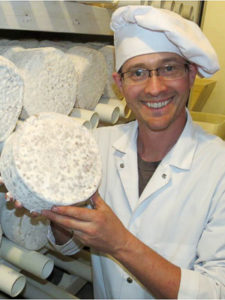

Planet Cheese is a weekly blog devoted to everything cheese: products, people, places, news, and views. James Beard Award–winning journalist Janet Fletcher writes Planet Cheese from her home in Napa Valley. Janet is the author of Cheese & Wine, Cheese & Beer, and The Cheese Course and an occasional contributor to culture. Visit janetfletcher.com to sign up for Planet Cheese and view Janet’s current schedule of cheese appreciation classes.
Thank you, cheese fans, for keeping the faith. You get it. You haven’t abandoned raw-milk cheeses despite the recent tragic incident traced to Vulto Creamery. Raw-milk cheesemakers like John Shuman at Cascadia Creamery feared a sales plunge, but it hasn’t materialized. You didn’t panic. Reassured, Shuman has resumed production of Sawtooth (above) after a self-imposed pause. That has to be a relief for this small family business and it’s welcome news for us. When a cheese this good is a casualty, everyone loses.
John and Marci Shuman operate Cascadia Creamery in the tiny burg of Trout Lake in southern Washington, a longtime dairy area. Their milk comes from a nearby dairy that has been certified organic for decades. The cows are grass-fed heirloom breeds with A2 genetics; some studies suggest that A2 milk is more digestible, although I don’t know if that benefit extends to cheese made from A2 milk.

Shuman with Cascadia Creamery Cloud Cap
Shuman makes only raw-milk cheeses and matures most of them inside a natural lava-tube cave, part of a network of underground caves in this volcanic area. The cool, steady temperature and humidity and gentle airflow are just what cheese wants, as Europe’s long tradition of cave aging confirms. But of course, the FDA does not see things that way. An aging room must have cleanable walls and a floor drain.
Shuman modified the cave to pass muster, and he also pipes some of that cave air into an above-ground aging room, where the 4½-pound Sawtooth spends two months. Over that time, it receives regular brine washings to develop a damp, flesh-colored rind and a beefy, yeasty aroma.
Resembling a French Saint-Nectaire, Sawtooth has a semisoft butter-colored interior with many tiny openings. The rind is thin and edible, the texture fudgy, the aroma like proofing yeast. Fans of super-stinky cheeses may find Sawtooth too tame; I consider it balanced, perfectly salted and easy to like, the sort of cheese that calls for dark bread and some sliced sweet onion. Open a yeasty Belgian-style beer, like Russian River Brewing’s Redemption, and there’s lunch.
Because of the production slowdown, some distributors have a temporary supply gap. Shuman expects to release a new batch of Sawtooth next week. In California, look for it at Milk Farm and Vagabond Cheese in Los Angeles; Oxbow Cheese Merchant in Napa; Venissimo Cheese in the San Diego area; and Whole Foods Harrison Street in San Francisco. On the East Coast, check Di Bruno Bros in Philadelphia; Eataly and Lucy’s Whey in Manhattan; Fairfield Cheese, Greenwich Cheese and Darien Cheese in Connecticut; The Wine Source in Baltimore; Provisions in Northampton, MA; and Whole Foods Northeast region. Check Cascadia Creamery’s website for other locations.




